
A cappuccino is an espresso-based coffee drink that is traditionally prepared with steamed milk foam (microfoam).

The soybean, soy bean, or soya bean is a species of legume native to East Asia, widely grown for its edible bean, which has numerous uses.

Caffè latte, often shortened to just latte in English, is a coffee drink of Italian origin made with espresso and steamed milk. Variants include the chocolate-flavored mocha or replacing the coffee with another beverage base such as masala chai, mate, matcha, turmeric or rooibos; alternatives to milk, such as soy milk or almond milk, are also used.

Textured or texturized vegetable protein (TVP), also known as textured soy protein (TSP), soy meat, or soya chunks is a defatted soy flour product, a by-product of extracting soybean oil. It is often used as a meat analogue or meat extender. It is quick to cook, with a protein content comparable to certain meats.
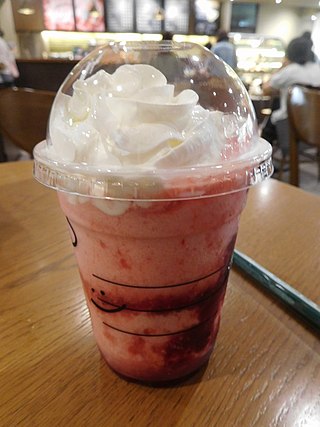
Frappuccino is a line of blended iced coffee drinks sold by Starbucks. It may consist of coffee or crème base, blended with ice and ingredients such as flavored syrups and usually topped with whipped cream and or spices. It may also include blended Starbucks refreshers. Frappuccinos are also sold as bottled coffee beverages in grocery stores, convenience stores and from vending machines.

Ristretto is a "short shot" of a more highly concentrated espresso coffee. It is made with the same amount of ground coffee, but extracted with a finer grind using half as much water. A normal short shot might look like a ristretto, but in reality, would only be a weaker, more diluted, shot. The opposite of a ristretto is a lungo ("long"), which has double the amount of water. The French call a ristretto a café serré.

Horchata, or orxata, is a name given to various beverages, which are generally plant based, but sometimes contain animal milk. In Spain, it is made with soaked, ground, and sweetened tiger nuts. In Latin America and other parts of the Americas, the base is jicaro, melon or sesame seeds, or white rice, along with other spices. Different varieties can be served hot or cold, and may be used as a flavor in other beverages, such as frappé coffee.

Rice pudding is a dish made from rice mixed with water or milk and other ingredients such as cinnamon, vanilla, and raisins.
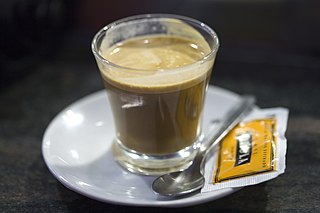
A cortado is a beverage consisting of espresso mixed with a roughly equal amount of warm milk to reduce the acidity, although the exact ratios have considerable regional variation. The milk in a cortado is steamed, but not frothy and "texturized" as in many Italian coffee drinks. The cortado comes from Spain, most likely Madrid, where it is commonly served. The word cortado is the past participle of the Spanish verb cortar, in the sense of "dilute", and can refer variously to either coffee or espresso drinks throughout Spanish and Portuguese speaking countries.
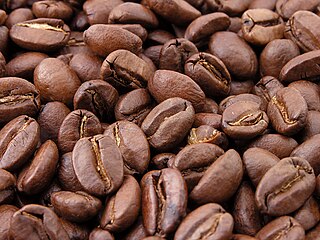
A coffee bean is a fruit from the Coffea plant and the source for coffee. It is the pip inside the red or purple fruit. This fruit is often referred to as a coffee cherry, and like the cherry, it is a stone fruit. Even though the coffee beans are not technically beans, they are referred to as such because of their resemblance to true beans. The fruits most commonly contain two stones with their flat sides together. A small percentage of cherries contain a single seed, instead of the usual two, called a "peaberry". The peaberry occurs only between 10% and 15% of the time, and it is a fairly common belief that they have more flavour than normal coffee beans. Like Brazil nuts and white rice, coffee beans consist mostly of endosperm.
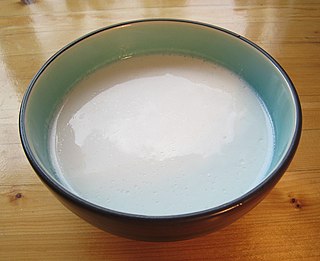
Plant milk is a plant beverage with a color resembling that of milk. Plant milks are non-dairy beverages made from a water-based plant extract for flavoring and aroma. Plant milks are consumed as alternatives to dairy milk, and may provide a creamy mouthfeel.

A milk substitute is any substance that resembles milk and can be used in the same ways as milk. Such substances may be variously known as non-dairy beverage, nut milk, grain milk, legume milk, mock milk and alternative milk.

A flat white is a coffee drink consisting of espresso with microfoam. It generally has a higher proportion of espresso to milk than a caffè latte, and a thinner layer of microfoam than a cappuccino. Although the term "flat white" was used in the United Kingdom to describe a type of espresso-based drink in the 1960s, the modern flat white was developed in Australia and New Zealand.
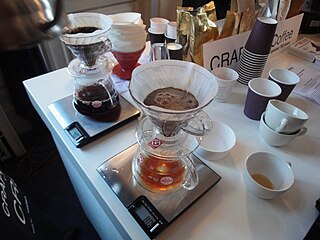
Coffee preparation is the process of turning coffee beans into liquid coffee. While the particular steps vary with the type of coffee and with the raw materials, the process includes four basic steps: raw coffee beans must be roasted, the roasted coffee beans must then be ground, and the ground coffee must then be mixed with hot or cold water for a specific time (brewed), the liquid coffee extraction must be separated from the used grounds, and finally, if desired, the extracted coffee is combined with other elements of the desired beverage, such as sweeteners, dairy products, dairy alternatives, or toppings.

Tylosema esculentum, with common names gemsbok bean and marama bean or morama bean, is a long-lived perennial legume native to arid areas of southern Africa. Stems grow at least 3 metres (9.8 ft), in a prostrate or trailing form, with forked tendrils that facilitate climbing. A raceme up to 25 millimetres (1 in) long, containing many yellow-orange flowers, ultimately produces an ovate to circular pod, with large brownish-black seeds.

Soy protein is a protein that is isolated from soybean. It is made from soybean meal that has been dehulled and defatted. Dehulled and defatted soybeans are processed into three kinds of high protein commercial products: soy flour, concentrates, and isolates. Soy protein isolate has been used since 1959 in foods for its functional properties.
The following outline is provided as an overview of and topical guide to chocolate:

Matcha is finely ground powder of specially grown and processed green tea leaves originating in China traditionally consumed in East Asia. It is mostly produced in Japan today. The green tea plants used for matcha are shade-grown for three to four weeks before harvest; the stems and veins are removed during processing. During shaded growth, the plant Camellia sinensis produces more theanine and caffeine. The powdered form of matcha is consumed differently from tea leaves or tea bags, as it is suspended in a liquid, typically water or milk.
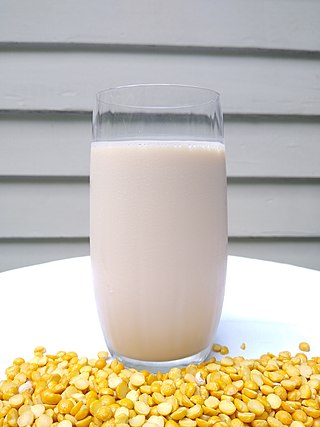
Pea milk is a type of plant milk. It is made using pea protein extracted from yellow peas, usually in combination with water, sunflower oil, micronutrients added for food fortification, thickeners, and phosphates. Commercial pea milk typically comes in sweetened, unsweetened, vanilla and chocolate flavors. It is marketed as a more environmentally-friendly alternative to almond milk and a non-GMO alternative to soy milk. It is a suitable product for people with soy allergies.


















